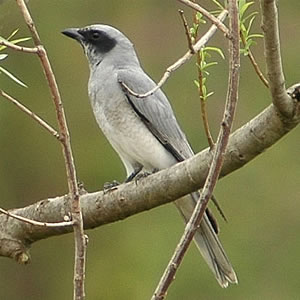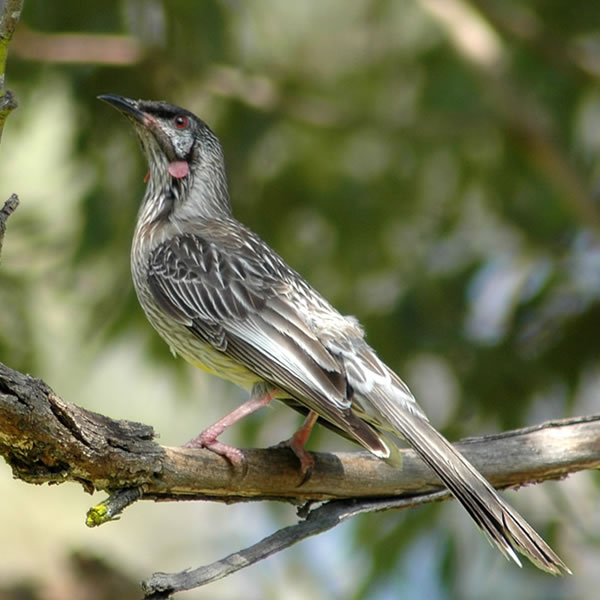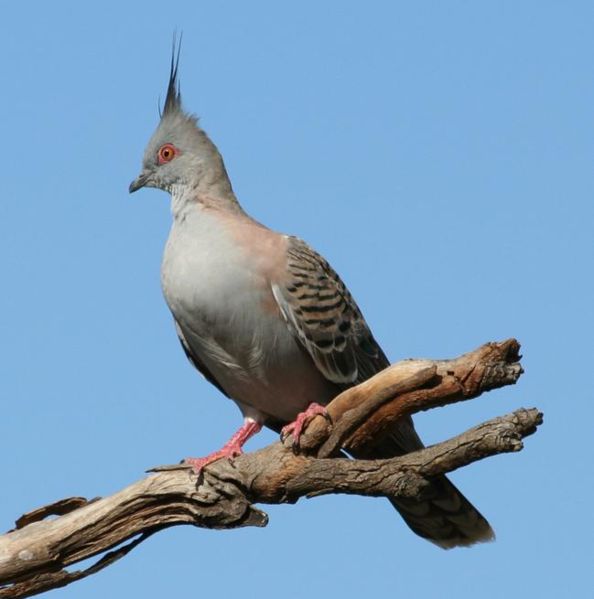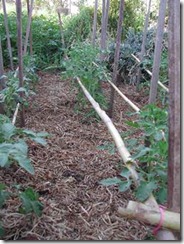Circa 2005: from the book Tales of a Backyard Farmer
‘Has-beans’ in the veggie patch
Some strange things are happening in the ecological balance of this garden as the heat of summer builds. I haven’t been as conscious of this in other years, but as the veggie patch has expanded, the hours spent in the garden have expanded too, and so therefore have the hours available for observation and reflection.
As a boy, I lived just a few kilometres from here, and one of the first native birds I was able to identify in the red-capped gum that grew on the footpath were musk lorikeets – small brilliant green parrots with a red stripe through the eye. These were said to flock with rainbow lorikeets, which are patchworks of purple, red, orange, yellow and green – yet it was years before I saw these in the garden. But today the mix has reversed – the rainbow lorikeets swarm over the apricots and almond trees, and only rarely have I sighted a musk lorikeet or a purple-crowned lorikeet among them.
In spring the biodiversity in the wildlife over the garden was greater then it is now as the New Year commences. It’s as though some of the native bird species have retreated to the hills as the nectar flows in the flowering suburbs have declined, or have moved on in some migration pattern I don’t understand. One of the great memories of this past Spring was the sight of a pair of black-faced cuckoo-shrikes landing on the fence on a grey morning, outlined against the brilliant white of the cherry blossoms.  Another time a zebra finch came by, with its black-and-white striped chest and orange eye patches, looking like a small convict. As Zebra finches are a flock bird of desert regions, I reckoned this one must have been an escapee from a cage somewhere – who am I to dob him in?
Another time a zebra finch came by, with its black-and-white striped chest and orange eye patches, looking like a small convict. As Zebra finches are a flock bird of desert regions, I reckoned this one must have been an escapee from a cage somewhere – who am I to dob him in?
Yet some native species are building up – in particular the red-wattle birds – the largest of the Australian honey-eaters – with their striated black and white backs, lemon yellow abdomens and the small red turkey-like “wattles” that hang beside their beaks. Their harsh “kwak-a-kwark” call can be heard as they hunt through the foliage and hoe into the fruit to be found in the local gardens. But these are the exception, as the smaller honeyeaters have all but disappeared, and the introduced species have become more common. Sparrows, starlings and blackbirds have been breeding up, and are all over the garden fossicking about for anything edible.  These birds are omnivorous, and so have adapted well to the company of man, himself an alien in this landscape.
These birds are omnivorous, and so have adapted well to the company of man, himself an alien in this landscape.
What I don’t understand is the absence of the Australian crested pigeon, which wears a spike on his head over a uniform of soft grey with bronze wing patches. These are common enough locally – I see them along the creek line every morning on the way to work, where small flocks of them whistle upwards on whirring wings as I approach. Perhaps they just enjoy the presence of native plant species along the creek, but I suspect that they are locked out of the available “pigeon niche” in the suburbs by the Indian turtledove.  This is another introduced species that can be seen along the roof caps or on power lines, bobbing and cooing to some apparently disinterested female, or fluttering about mating or bashing each other with their wings in what must be the usual male rivalry.
This is another introduced species that can be seen along the roof caps or on power lines, bobbing and cooing to some apparently disinterested female, or fluttering about mating or bashing each other with their wings in what must be the usual male rivalry.
I hadn’t realized until a few months ago that there’s all sorts of rivalry going on in (as distinct from above!) the veggie patch as well. At the Seed Savers weekend in Adelaide in October, all sorts of folk were swapping all sorts of strange and wondrous veggie seeds.
I knew nothing about any of this, and found it all fascinating. Since the early 1900’s, nearly 97% of our veggie seed heritage has disappeared. The bigger seed companies have rationalized the varieties they carried or produced hybrid varieties designed for commercial growers as the home-gardener market dwindled away with our accelerating life-style and the disappearance of the backyard veggie patch. The Seed-Savers network was set up to save and reproduce the “heirloom” varieties of vegetables that are our rightful inheritance. These seeds have been passed down from generation to generation, are not patented or genetically modified, and have been found to work best under local conditions. Many of these older varieties had characteristics that we can ill-afford to lose from the gene pool.
Perhaps they had heavier yields, were more disease resistant, grew better in colder climates, yielded over a longer period, or just had soft and delicious fruit that were unsuitable for shipments to far-off markets, but were perfect for the local table.
Here was a whole New World! Suddenly I could see where the smaller seed companies fitted into the picture – those who offer these heirloom varieties. These open-pollinated non-hybrid vegetable seeds come in paper packets with simple labels, from companies like Eden Seeds or Greenpatch Seeds up in Queensland, or the Digger’s Club in Victoria. Using simple seed packets makes it possible for these smaller companies to offer the diversity and range that’s just not available from the bigger companies, with their shiny printed packets in full gorgeous colour (minimum print run 60,000!). One of the bigger brands infuriates me by replacing advice to the gardener with advertising: “Raise in trays of Brand-X Seed Raising Mix. Add Brand-X Complete Plant Food before transplanting. Apply Brand-X Soluble Fertilizer regularly for best growth. Protect young seedlings from slugs and snails with Brand-X [snail killer]”. Spend three dollars on seeds and thirty dollars on chemicals? What’s wrong with soil, mulch and compost?
Right – no point just talking about it! Back to the veggie patch to try it out! My main tomato crop (about 100 vines) consists of Ox-heart tomatoes for the table and Roma tomatoes for sauce. One area of my compost-covered beds I use just for raising seed. I do this as simply as possible, by leveling a small area about 500mm x 500mm, ruffling the surface with my fingertips and sprinkling all the seeds from one packet onto this surface. I then stir them around some more to bury them a bit, cover with a thin layer of the same soil then smack them down with the flat of my hand to ensure the seed is bedded in tightly. I water them daily with rainwater, as they are pretty delicate to begin with, and sensitive to temperature and moisture swings. Using this technique, I raised Mortgage Lifter tomatoes (giants!), Yellow Pear tomatoes (yellow and pear shaped!) and Rouge de Marmand (flat and red!) – all these are heirloom varieties.
Finally, with somewhat more care, I planted out about twenty seeds of the rare Bell Star tomatoes, which we’d been given privately at the Seed Saver weekend, and which are a bush or “paste” tomato. After all these tomato seedlings reached 10cm to 20cm in height, I lifted them in great clumps with the shovel, then broke them apart and transplanted them directly into the beds, buried as deeply as I could. Some I covered with the trampoline for a few days to give them shade and protection against the hot sun, while their shattered root systems recovered and started pushing out in the search for moisture. It’s still early days, but all these heirloom tomatoes have survived and are healthy and strong. If we like them, we’ll save their seed, and keep propagating them ourselves in years to come, rather than relying on buying new seed each year.
 And then there were the beans! I can make no claims to having been an adventurous bean grower – each year I buy Gourmet Dwarf Beans, and that’s what we eat. They are a tasty stringless bush bean for eating green, but bear only over a short period, and so I plant new crops periodically. Bill at the Seed-Savers weekend had raised about ninety different varieties of beans, and during his talk, passed around packets of seeds ranging from delicate browns and deep reds to white ones with purple flashes. Every thing else was interesting – this was fascinating! So I bought home lots of packets of bean seeds, all with wonderfully evocative names – Nicaraguan Red Bean, Purple Queen, Double Princess, Pink Bush Bean, Tongue of Fire Bush Bean, Bountiful Dwarf, Redlands Greenleaf, White Marrowfoot, Royalty Purple Pod and Scarlet Beauty. This was all sheer indulgence! But I did like the idea that many of these beans are for drying, so that one can raise a crop and store the dried beans for winter eating.
And then there were the beans! I can make no claims to having been an adventurous bean grower – each year I buy Gourmet Dwarf Beans, and that’s what we eat. They are a tasty stringless bush bean for eating green, but bear only over a short period, and so I plant new crops periodically. Bill at the Seed-Savers weekend had raised about ninety different varieties of beans, and during his talk, passed around packets of seeds ranging from delicate browns and deep reds to white ones with purple flashes. Every thing else was interesting – this was fascinating! So I bought home lots of packets of bean seeds, all with wonderfully evocative names – Nicaraguan Red Bean, Purple Queen, Double Princess, Pink Bush Bean, Tongue of Fire Bush Bean, Bountiful Dwarf, Redlands Greenleaf, White Marrowfoot, Royalty Purple Pod and Scarlet Beauty. This was all sheer indulgence! But I did like the idea that many of these beans are for drying, so that one can raise a crop and store the dried beans for winter eating.
This year its been a struggle to raise my usual beans, and I was beginning to suspect I was a has-been as a bean grower when we heard from the local market gardener that he was having trouble too. Good – being able to blame everything on the weather gave me the confidence to try out all these heirloom varieties, which I’ve committed to propagating in years to come.
At this time of year, space in the garden is at a premium, but I’m digging potatoes, and so I’m getting back good ground for growing other crops. I planted out my ten varieties of beans, and covered them with underfelt in the same technique I use for raising carrots – the underfelt allows you to water them while keeping the soil surface cool and moist. After five days I removed the covers, and every one of these beans (dated 1999!) had germinated, and weeks later, are all doing well. Some have purple stems, others have variegated leaves, and all are interesting. They’ll be able to say of me “he too has beans!”
In my own small way, I’ll be able to carry forward some part of our inheritance, contributing to the biodiversity in the veggie patches of future generations, so that they may enjoy them as I have.
(Bird photos courtesy of Wikipedia)








0 comments:
Post a Comment